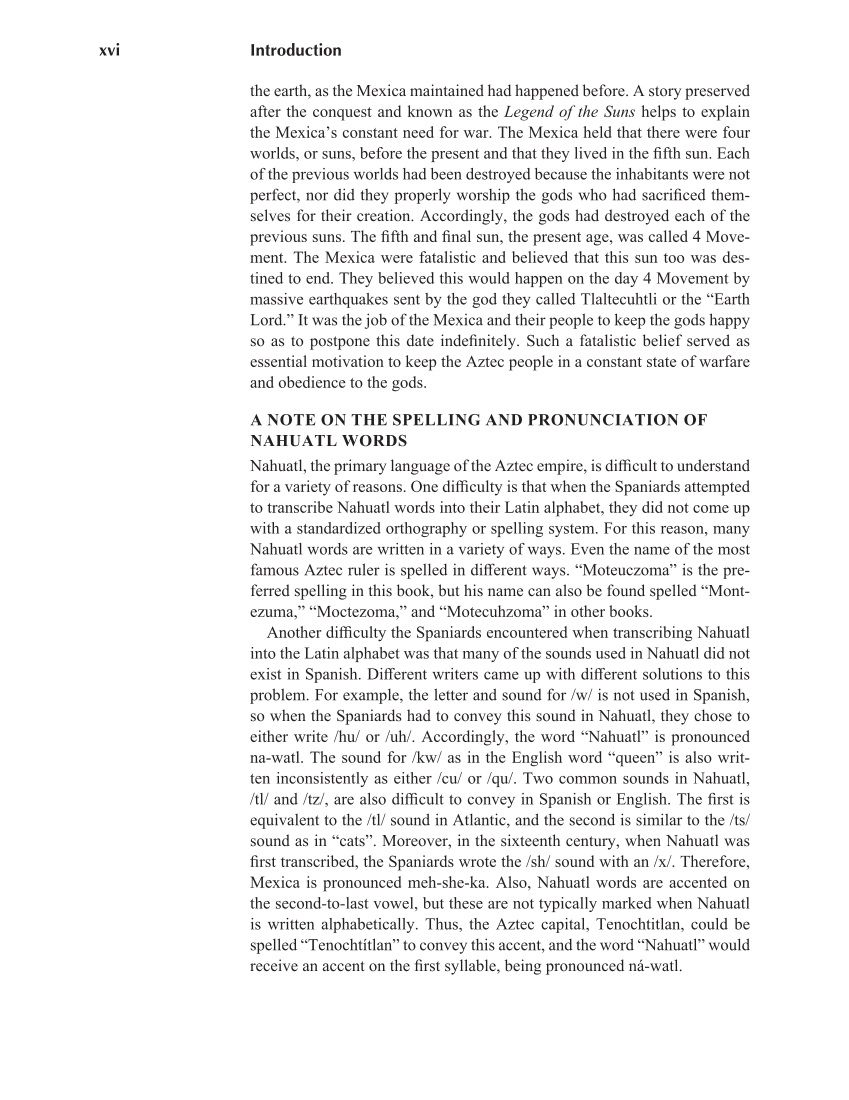Introduction xvi the earth, as the Mexica maintained had happened before. A story preserved after the conquest and known as the Legend of the Suns helps to explain the Mexica’s constant need for war. The Mexica held that there were four worlds, or suns, before the present and that they lived in the fifth sun. Each of the previous worlds had been destroyed because the inhabitants were not perfect, nor did they properly worship the gods who had sacrificed them- selves for their creation. Accordingly, the gods had destroyed each of the previous suns. The fifth and final sun, the present age, was called 4 Move- ment. The Mexica were fatalistic and believed that this sun too was des- tined to end. They believed this would happen on the day 4 Movement by massive earthquakes sent by the god they called Tlaltecuhtli or the “Earth Lord.” It was the job of the Mexica and their people to keep the gods happy so as to postpone this date indefinitely. Such a fatalistic belief served as essential motivation to keep the Aztec people in a constant state of warfare and obedience to the gods. A NOTE ON THE SPELLING AND PRONUNCIATION OF NAHUATL WORDS Nahuatl, the primary language of the Aztec empire, is difficult to understand for a variety of reasons. One difficulty is that when the Spaniards attempted to transcribe Nahuatl words into their Latin alphabet, they did not come up with a standardized orthography or spelling system. For this reason, many Nahuatl words are written in a variety of ways. Even the name of the most famous Aztec ruler is spelled in different ways. “Moteuczoma” is the pre- ferred spelling in this book, but his name can also be found spelled “Mont- ezuma,” “Moctezoma,” and “Motecuhzoma” in other books. Another difficulty the Spaniards encountered when transcribing Nahuatl into the Latin alphabet was that many of the sounds used in Nahuatl did not exist in Spanish. Different writers came up with different solutions to this problem. For example, the letter and sound for /w/ is not used in Spanish, so when the Spaniards had to convey this sound in Nahuatl, they chose to either write /hu/ or /uh/. Accordingly, the word “Nahuatl” is pronounced na-watl. The sound for /kw/ as in the English word “queen” is also writ- ten inconsistently as either /cu/ or /qu/. Two common sounds in Nahuatl, /tl/ and /tz/, are also difficult to convey in Spanish or English. The first is equivalent to the /tl/ sound in Atlantic, and the second is similar to the /ts/ sound as in “cats”. Moreover, in the sixteenth century, when Nahuatl was first transcribed, the Spaniards wrote the /sh/ sound with an /x/. Therefore, Mexica is pronounced meh-she-ka. Also, Nahuatl words are accented on the second-to-last vowel, but these are not typically marked when Nahuatl is written alphabetically. Thus, the Aztec capital, Tenochtitlan, could be spelled “Tenochtítlan” to convey this accent, and the word “Nahuatl” would receive an accent on the first syllable, being pronounced ná-watl.
Document Details My Account Print multiple pages
Print
You have printed 0 times in the last 24 hours.
Your print count will reset on at .
You may print 0 more time(s) before then.
You may print a maximum of 0 pages at a time.






























































































































































































































































































































































































































